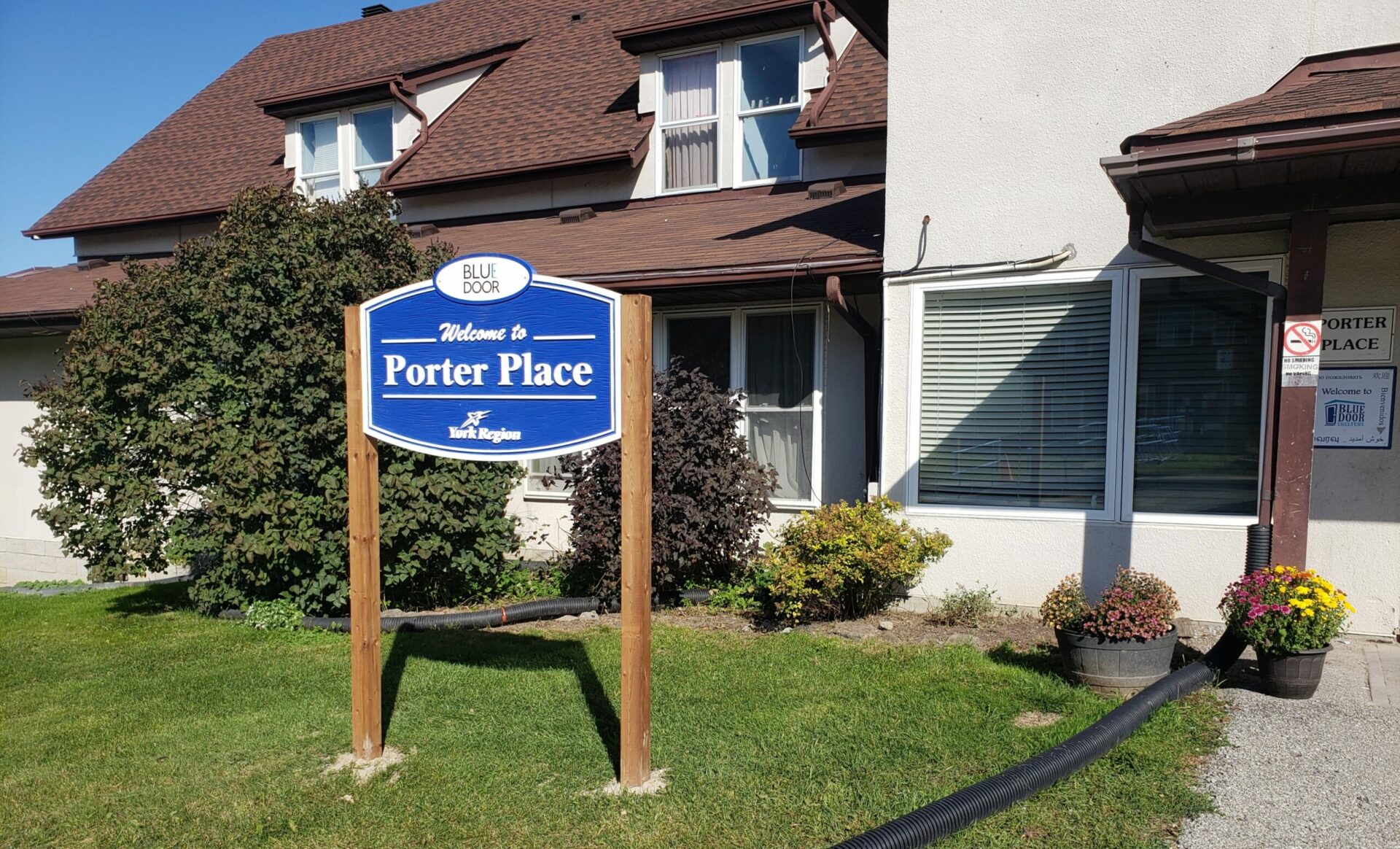Blue Door serves individuals experiencing homelessness in York Region, one of the most vulnerable populations in our society. Through thoughtful dialogue with representatives from Blue Door, The Town of Newmarket, York Region, and various community partners, we realized that there is a pressing need to strengthen community services for people experiencing homelessness, therefore re-developing Blue Door’s underutilized 100-year-old property which serves as the emergency housing program, Kevin’s Place.
1) Who is involved in this project?
This is a community partnership with EllisDon leveraging its extensive experience in public infrastructure, leading design-build teams, and financing; Blue Door bringing its operational expertise in the supportive and emergency housing sector; and Habitat for Humanity GTA conducting the build with opportunities for vulnerable people facing homelessness to gain employment and training through Blue Door’s construction social enterprise, Construct.
2) Where is this proposed development site located, and how is it zoned?
The property is at Gorham Street and Alexander Road on land owned by Blue Door and zoned “R1-B”, allowing for detached dwellings, bed and breakfasts, home occupation, group homes, accessory residential structures, and accessory uses. Blue Door is seeking to have this underutilized 100-year-old property rezoned into “R4” to accommodate new 14-unit purpose-built stacked townhouses.
3) What will the development look like?
A 14-unit townhouse development to provide supportive and emergency housing for individuals and families to successfully exit homelessness and transition into more permanent housing. The development includes:
- Four 3-bedroom units dedicated to Kevin’s Place emergency housing program.
- One 1-bedroom unit for Blue Door staff to provide housing, health, and employment support to anyone in the complex 24/7.
- Four 2-bedroom units, accessible and affordable, on the first floor.
- Nine 3-bedroom units, family-sized and affordable.
- Fourteen parking spaces for residents, visitors, and staff.
4) Why is an MZO needed?
An MZO is needed to expedite construction, meet CMHC funding deadlines and requirements, and serve as well as reduce the number of people experiencing homelessness. This includes women and their children fleeing violence; seniors; young adults; Indigenous peoples; people with disabilities; veterans, 2SLGBTQ+ people; racialized groups; and recent immigrants and refugees.
5) Does emergency housing work?
Eighty per cent of people who access an emergency program do so once and for a short duration, especially when this assistance is linked to income support and helps to locate affordable housing.
6) Why should the community support this?
Housing is a basic human right, and affordability provides access to this right. Canada has an affordable and supportive housing crisis, and every person left without a home is at risk of rapidly declining mental and physical health. Today, the cost of living continues to rise, income is stagnant, affordable housing is decreasing, and encampments are growing. We must support affordable housing solutions for the simple fact that – as humans, we can.
7) What is the difference between emergency, supportive and affordable housing?
Emergency housing is a more costly short-term shelter. It involves 24/7 staffing, shared facilities and typically lacks privacy and freedom to come and go. Supportive housing is for people who can live independently but require customized support to help ensure they can maintain their housing situation. Affordable housing through Blue Door is rent adjusted to income.
8) Will this development bring more people experiencing homelessness to Newmarket?
No. This development will add safe, supportive housing for all community members. Occupants could be our parents, siblings, or children – who can live independently, many of whom are employed, yet still can’t afford their rent. The project will help to reduce the number of people experiencing homelessness by providing supported pathways to exit homelessness through access to affordable and supportive housing.
9) Does York Region have a problem with homelessness?
Yes. In York Region alone, on any given night over 300 individuals experience homelessness, 20% of whom are families. According to the I Count: York Region’s 2021 Homeless Count, one-quarter of survey respondents cited an inability to pay rent/mortgage as a reason for their homelessness. Indigenous and Black populations continue to be overrepresented among individuals experiencing homelessness, and youth represent 1 in 7 people experiencing homelessness, with more than one-quarter of youth self-identifying as 2SLGBTQ+. It is important to note that homelessness in York Region is often hidden such as people finding shelter on transit, in coffee shops or through couch surfing.
10) What will this project mean for the Town of Newmarket?
This development is an opportunity for Newmarket to become a leader in innovating housing practices and addressing the national housing crisis by first dealing with our neighbours without a home. The Town of Newmarket will also be contributing to York Region’s planned 9,000 new housing units, of which 25% must be affordable and accessible.
11) What will this mean for York Region?
There are several benefits for York Region:
- This project will model how to strategically rethink land use and create urgently needed affordable housing in perpetuity without impacting taxpayers.
- It helps create space on the York Region subsidized housing waitlist, helping to more effectively move our community’s most vulnerable people along the housing continuum from homelessness to emergency housing to supportive and affordable housing.
- It is a response to Bill 23 that overlooks the need to preserve our community’s existing supply of affordable housing and ensure the same number of affordable rental units are incorporated into new developments.
- It demonstrates that York Region residents recognize the human right of housing for all.
12) Who is Blue Door?
Blue Door is a leader in creating programs that address and prevent homelessness and is changing how individuals, businesses, and governments approach Canada’s housing crisis. Our long-standing lifesaving support includes emergency and transitional housing for youth, men, 2SLGBTQ+ youth and families at risk of or experiencing homelessness in York Region. In 2022 alone, we provided over 30,000 nights of safety, 105,550 meals, and placed over 170 people in housing. To learn more about Blue Door, please read Blue Door’s 2022 Annual Impact Report.
13) What is Blue Door’s social purpose real estate portfolio?
Blue Door is building a social purpose real estate portfolio where acquired properties are turned into rent geared to income (30% of total income) housing, helping to reduce York Region’s subsidized housing waitlist.
14) How can I support this initiative Blue Door?
- Contact your local MP, MPP or Town Councilor to share your support for Blue Door’s housing project and the continued efforts to reduce poverty by all levels of government.
- Donate to support this and other life-saving work through Blue Door.
- Learn more about homelessness and affordable housing in York Region.



